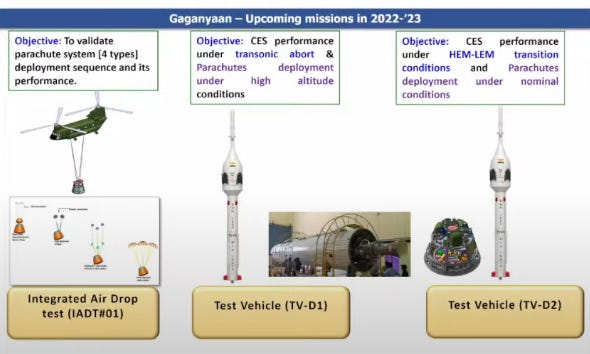Chairman, ISRO interview with The Hindu’s TS Subramanium
I shared details of the first flight of the SSLV-D1 in Pradeep’s Space Newsletter #40. A few days later The Hindu published an interview with Dr. Somanath, Chairman, ISRO. T S Subramanium did the interview. The interview is behind a paywall.
Dr. Somanath shared more details of the SSLV-D1 failure. He says that there was an issue with the measurement of the accelerometer at the point when the SSLV-D1’s second stage separated. The onboard computer decided that the accelerometer had failed. It shifted from closed-loop guidance to open-loop guidance.
In closed-loop guidance, feedback received from sensors or measurement devices like the accelerometer is used by the onboard computer to make adjustments in the rocket stages thrust or attitude control systems that guide the rocket to orbit. In open-loop guidance, the rocket follows the pre-programmed path to orbit without considering feedback.
He says that the anomaly lasted for only 2 seconds. Within this time, the onboard computer decided that the accelerometer had failed. If it had waited for another second, the onboard computer could have continued on closed-loop guidance, and perhaps the result of the mission may have been different.
The rocket then followed the open loop guidance path till satellite separation. Since the first three stages of the rocket are solid the rocket burnt them to completion. Solid stages of rockets cannot be stopped midway. Since the Velocity Trimming Module was liquid, I think it was stopped.
The satellites were placed in a 356 km x 76 km orbit. In this orbit, the atmospheric drag pulls down the satellite. The satellite is believed to have lasted only for 20 minutes.
Dr. Somanath believes that the rocket stages and the rocket as a whole performed properly. The issue is only with the logic in the onboard computer and possibly the accelerometer.
Speaking about Chandrayaan-3, he said that the orbiter will not carry any payloads. It will only act as a communication relay station. As u/Ohsin pointed out in the r/ISRO thread on this interview, there was a payload called Spectro-polarimetry of Habitable Planet Earth onboard Chandrayaan-3 (SHAPE) to fly on the orbiter. This was shared by ISRO in the COSPAR 2022 [PDF link] meeting.
Upcoming milestones in the Gaganyaan mission. Shows you the Test Vehicle as well. Source: r/ISRO
GSLV Mk III model built using LEGO Blocks. Source: via r/ISRO
Gaganyaan flights with humans are likely only after 6 flights. There will be 4 flights of the test vehicle (seen in the image above) and 2 flights of the GSLV human spaceflight stack. The stack can be seen on the left in the LEGO model.
The upcoming flight is of the GSLV Mk III commercial flight (carrying OneWeb satellites), the PSLV C-54 mission with EOS-06/Oceansat-3, and the SSLV-D2 mission.
I am happy with how open ISRO has been with details related to this mission. I hope this streak continues.
ISRO Updates
When the Virtual Space Museum announcement dropped on the ISRO website, it was @Astro_Neel who had shared on Twitter the video of Chandrayaan-2’s Lander Actuator Performance Test from the Virtual Space Museum.


I wish ISRO does a better job with captioning these videos. So, enthusiasts like us have to get down to answer questions like where ISRO conducted these tests. @Astro_Neel then used Google Earth to locate the test location at ISRO Propulsion Complex (IPRC) at Mahendragiri.





August 12 was the birth anniversary of Vikram Sarabhai, the father of the Indian space programme. Sharing this wonderful note written after the quote about space for the benefit of all humankind.







